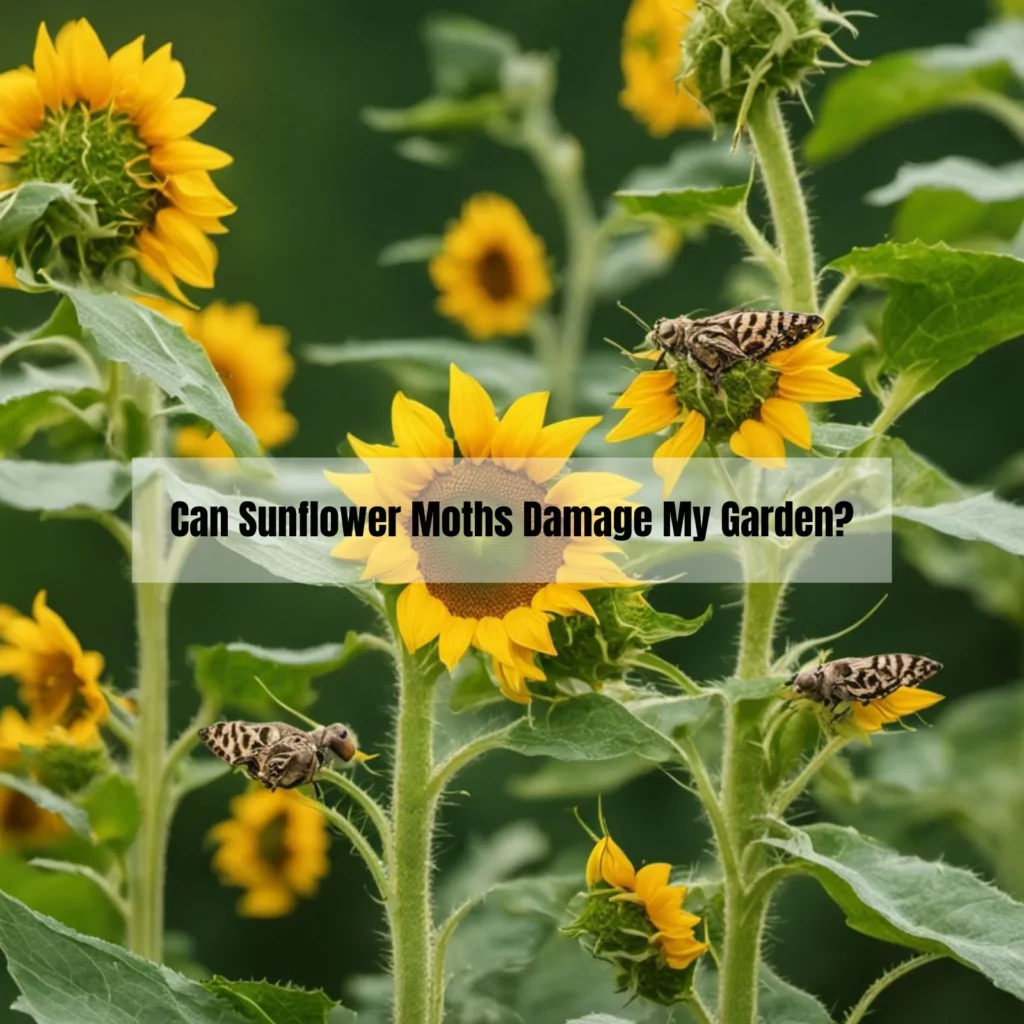Say Goodbye to Sunflower Moths: Tips and Tricks for Effective Removal
Are pesky moths damaging your sunflowers? Sunflower moths commonly afflict gardeners, laying their eggs on sunflower heads, and their larvae consume the seeds, harming the flowers. Left unchecked, these moths can significantly harm your garden.
Sunflower moths are small, gray-brown insects that deposit eggs on sunflower heads. Their larvae feed on sunflower seeds, causing damage, and they are most active in summer.
To combat sunflower moths, you can employ various methods, such as natural remedies and chemical treatments, to effectively eliminate them and prevent their return.
In this article, we’ll explore how to eliminate and prevent sunflower moth infestations.
Key Takeaways
- Sunflower moths are small, gray-brown moths that lay their eggs on the sunflower head.
- The larvae of the sunflower moth feed on the seeds of the sunflower, causing damage to the plant.
- By using a combination of natural remedies and chemical treatments, you can effectively get rid of sunflower moths and prevent them from returning.

Understanding Sunflower Moths
If you’re a sunflower grower, you’ve probably dealt with sunflower moths at some point. These pesky insects can cause significant damage to your sunflower crop if left unchecked.
Here’s what you need to know about sunflower moths to understand how to get rid of them.
Identification
Sunflower moths are small, buff to gray colored moths with a wingspan of about 0.75 inches. Their larvae are small, worm-like creatures that feed on the developing seeds of sunflowers.
You can identify sunflower moth larvae by their brown head capsule and alternate dark and light lines running longitudinally on their body.
Life Cycle
Sunflower moths have one to two generations per year, depending on the region. In warmer climates, they may have up to three generations per year. The adult moths lay their eggs on the flowers of sunflower plants.
The larvae then hatch and tunnel into the developing seeds to feed. After about two weeks, the larvae pupate and emerge as adult moths.
Damage
Sunflower moth larvae can cause significant damage to sunflower crops by feeding on the developing seeds. This can lead to reduced seed quality and yield. In severe infestations, the larvae can cause the entire head of the sunflower to wilt and die.
Prevention and Control
Preventing and controlling sunflower moths involves a combination of cultural, mechanical, and chemical methods. Here are some tips:
- Plant sunflowers early to avoid peak moth activity.
- Monitor your sunflower crop regularly for signs of infestation.
- Remove and destroy any infested heads or plants.
- Use pheromone traps to monitor moth activity and determine when to apply control measures.
- Apply Bacillus thuringiensis (Bt) to control larvae. Bt is an organic solution that kills the larvae of butterflies and moths, including sunflower moths.
- Use insecticides as a last resort and follow label instructions carefully.
By understanding the life cycle and behavior of sunflower moths, you can take steps to prevent and control infestations. With proper management, you can protect your sunflower crop and ensure a successful harvest.
How to Get Rid of Sunflower Moths

Sunflower moths are a common pest that can wreak havoc on your sunflower plants. These moths lay their eggs on the flowers, and the larvae feed on the seeds, causing them to become deformed and unusable.
Here are some tips on how to get rid of sunflower moths.
Identifying Sunflower Moths
Before you can get rid of sunflower moths, you need to be able to identify them. Sunflower moths are small, about 1/2 inch in length, and gray or brown in color.
They have two wings that are covered in small scales, and their antennae are long and thin. The larvae are small and white, with black heads.
Natural Predators
One way to get rid of sunflower moths is to introduce natural predators into your garden. Some natural predators of sunflower moths include:
- Parasitic wasps
- Tachinid flies
- Ladybugs
- Lacewings
You can attract these predators to your garden by planting flowers that they like, such as daisies and marigolds. You can also purchase them online or at a garden center.
Pest Control Methods
If natural predators are not enough to get rid of sunflower moths, there are several pest control methods that you can use:
- Pesticides: Use a pesticide that is specifically labeled for sunflower moths. Be sure to follow the instructions on the label carefully to avoid harming other insects or animals.
- Traps: You can create a trap for sunflower moths by placing a sticky trap near the affected plants. The moths will be attracted to the trap and get stuck.
- Neem oil: Neem oil is a natural insecticide that can be used to get rid of sunflower moths. Mix one tablespoon of neem oil with one quart of water and spray it on the affected plants.
Remember to always read the label and follow instructions when using pesticides or other pest control methods.
How to Prevent Sunflower Moths?
Sunflower moths can be a real pain in the neck for sunflower growers. But don’t worry, there are a few simple steps you can take to prevent these pesky moths from ruining your sunflower crop.
1. Plant Sunflowers Early
Planting sunflowers early in the season can help prevent sunflower moths from infesting your crop. Sunflowers planted early have a better chance of growing taller and stronger, which can make it harder for the moths to lay their eggs.
2. Rotate Your Crops
Sunflower moths tend to lay their eggs in the same spot year after year. By rotating your sunflower crop with other crops, you can help break the moth’s life cycle and reduce the chances of an infestation.
3. Use Insecticides
Insecticides can be an effective way to prevent sunflower moth infestations. Look for insecticides containing the active ingredients carbamate, endosulfan, or methidathion.
Apply the insecticides when the sunflowers begin to shed pollen, which is when the eggs of the moths have hatched and the larvae are beginning to grow but before the seeds have formed.
4. Attract Natural Predators
Encouraging natural predators like birds and beneficial insects can be an effective way to control sunflower moth populations. Planting flowers and other plants that attract these predators can help keep sunflower moths at bay.
5. Monitor Your Crop
Regularly monitoring your sunflower crop for signs of sunflower moths can help you catch an infestation early and take action before it gets out of hand. Look for signs like small holes in the leaves, wilting, or stunted growth.
By following these simple steps, you can help prevent sunflower moths from infesting your sunflower crop and ensure a healthy harvest.
Are Sunflower Moths Harmful?
If you’re growing sunflowers, you may have heard of sunflower moths. These small, silvery-gray moths are common pests that can cause damage to your sunflowers. But are they harmful enough to warrant action? Let’s take a closer look.
Sunflower moths lay their eggs at the base of sunflower florets, and the larvae feed on the developing seeds. This can result in reduced seed production and smaller, misshapen seeds. In severe cases, the larvae can cause the entire head of the sunflower to wilt and die.
While sunflower moths can certainly cause damage, they are not typically considered a major threat to sunflower crops. In fact, many gardeners and farmers simply accept a certain level of damage from sunflower moths as a natural part of growing sunflowers.
That being said, if you’re seeing a significant amount of damage to your sunflowers, it may be worth taking action to control the moth population. Here are some steps you can take:
- Monitor your sunflowers regularly for signs of sunflower moth activity, such as small holes in the petals or larvae feeding on the seeds.
- Remove any damaged or infested flowers from the plant and dispose of them in the trash (not the compost).
- Consider using an insecticidal soap or other organic insecticide to control the moth population. Be sure to follow the instructions carefully and apply the product only as directed.
By taking these steps, you can help keep sunflower moth damage under control and ensure a healthy crop of sunflowers. Remember, a little bit of damage is normal and not necessarily cause for concern. But if you’re seeing significant damage, it’s worth taking action to protect your plants.
Can Sunflower Moths Damage My Garden?

If you’re a sunflower lover, you might have noticed some small moths flying around your garden. These little guys are called sunflower moths, and while they might seem harmless, they can actually cause some damage to your garden. Here’s what you need to know:
What are Sunflower Moths?
Sunflower moths are small, grayish-brown moths with a wingspan of about 1 inch. They are most active during the summer months and are attracted to sunflowers because they lay their eggs on the flowers. The larvae then feed on the seeds of the sunflowers, causing damage to the plant.
How Do Sunflower Moths Damage My Garden?
Sunflower moths can cause damage to your garden in a few ways:
- Seed Damage: The larvae of sunflower moths feed on the seeds of sunflowers, which can cause damage to the plant. This damage can result in reduced seed production and poor quality seeds.
- Stem Damage: Sunflower moths can also cause damage to the stems of sunflowers. The larvae burrow into the stems, causing the plant to weaken and potentially die.
- Spread of Disease: Sunflower moths can also spread diseases to your sunflowers, which can cause further damage to the plant.
How Can I Get Rid of Sunflower Moths?
If you’ve noticed sunflower moths in your garden, there are a few things you can do to get rid of them:
- Remove Infested Plants: If you have sunflowers that are infested with sunflower moths, it’s best to remove them from your garden to prevent further damage.
- Use Pesticides: There are a variety of pesticides available that can help control sunflower moths. Look for a pesticide that is labeled for use on sunflowers and follow the instructions carefully.
- Plant Resistant Varieties: Some sunflower varieties are more resistant to sunflower moths than others. Consider planting a variety that is known to be resistant to sunflower moths to help prevent infestations.
- Practice Good Garden Hygiene: Keeping your garden clean and free of debris can help prevent sunflower moths from taking up residence. Remove any dead or dying plants and clean up fallen leaves and other debris regularly.
With a little bit of effort, you can keep sunflower moths from causing damage to your garden. Keep an eye out for these little pests and take action as soon as you notice them to prevent further damage to your sunflowers.
Frequently Asked Questions (FAQs)
What are some natural ways to control sunflower moth infestations?
There are several natural ways to control sunflower moth infestations, including:
- Planting sunflowers that are resistant to sunflower moths, such as the ‘Italian White’ variety.
- Introducing natural predators, such as parasitic wasps, to your garden.
- Using pheromone traps to lure male moths away from female moths, thus preventing them from mating and laying eggs.
- Keeping your garden clean and free of debris where moths can lay their eggs.
What are some home remedies to get rid of sunflower moths?
There are several home remedies that can help get rid of sunflower moths, such as:
- Spraying a mixture of water and dish soap on the affected plants.
- Sprinkling diatomaceous earth around the base of the plants.
- Applying neem oil to the plants.
How can I prevent sunflower moth caterpillars from damaging my sunflowers?
To prevent sunflower moth caterpillars from damaging your sunflowers, you can:
- Plant sunflowers that are resistant to sunflower moths.
- Use pheromone traps to lure male moths away from female moths, thus preventing them from mating and laying eggs.
- Inspect your sunflowers regularly for signs of infestation, such as holes in the leaves or flower heads.
What are some effective insecticides to use on sunflowers to control pests?
There are several effective insecticides that can be used on sunflowers to control pests, such as:
- Spinosad, which is a natural insecticide derived from soil bacteria.
- Pyrethrin, which is a natural insecticide derived from chrysanthemum flowers.
- Bacillus thuringiensis (Bt), which is a natural insecticide that is toxic to caterpillars.
Are there any natural predators of sunflower moths?
Yes, there are several natural predators of sunflower moths, including:
- Parasitic wasps, which lay their eggs inside the moth larvae.
- Tachinid flies, which lay their eggs on the moth larvae.
- Birds, which feed on the adult moths and larvae.
What kind of damage do sunflower moths cause to sunflowers?
Sunflower moths can cause several types of damage to sunflowers, including:
- Holes in the leaves and flower heads.
- Damage to the developing seeds, which can reduce the yield of the sunflower.
- Reduced seed quality, which can affect the viability of the seeds for planting.
Conclusion
Getting rid of sunflower moths is not an easy task, but it can be done with the right approach. By following the tips and techniques discussed in this article, you can effectively control and prevent the spread of sunflower moths in your garden.
First and foremost, it is important to regularly monitor your sunflowers for signs of infestation. Look out for silver-gray moths, larvae, and eggs on the heads of the sunflowers. If you spot any of these signs, take immediate action to prevent the infestation from spreading.
One effective method of controlling sunflower moths is through the use of insecticides. Apply insecticides containing active ingredients such as carbamate, endosulfan, or methidathion according to the manufacturer’s directions. It is recommended to apply the insecticides when the sunflowers begin to shed pollen, as this is when the eggs of the moths have hatched and the larvae are beginning to grow.
Another effective approach is to use biological control methods. Parasitic wasps and flies can be used to control the population of sunflower moths in your garden. Certain parasitic flies of the family Tachinidae are slightly more successful because they deposit live larvae able to penetrate the flower in search of a host.
In addition to these methods, there are several cultural practices you can adopt to prevent the spread of sunflower moths. These include planting sunflowers away from other crops, rotating your crops, and keeping your garden clean and free of debris.
Remember, prevention is always better than cure. By taking the necessary steps to prevent sunflower moth infestations, you can save yourself a lot of time, effort, and money in the long run. With a little bit of effort and careful planning, you can keep your sunflowers healthy and free from pests.






